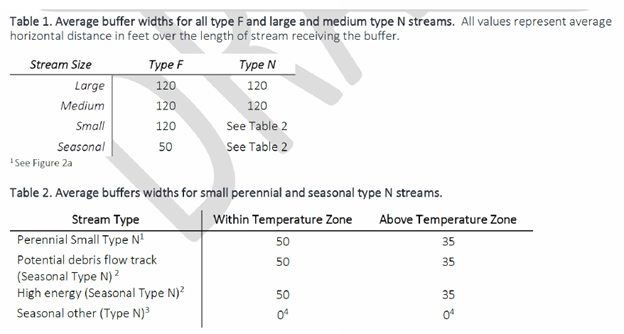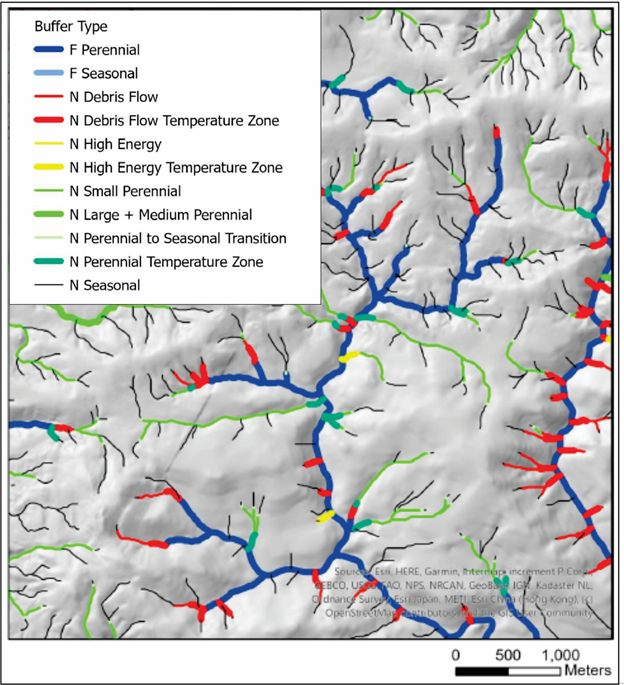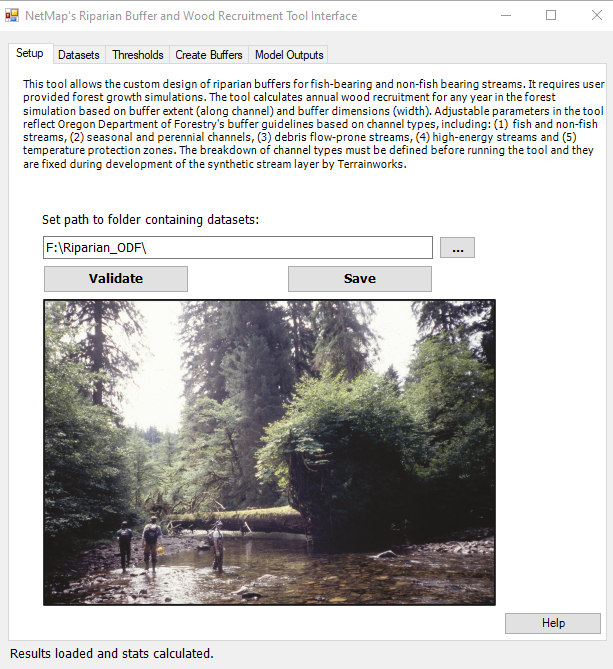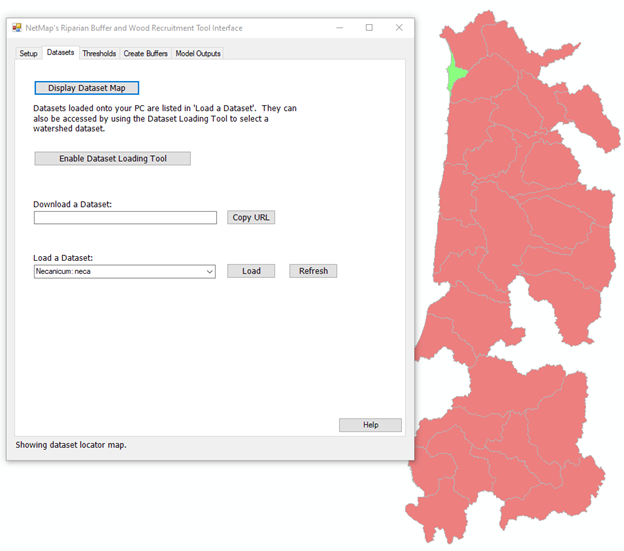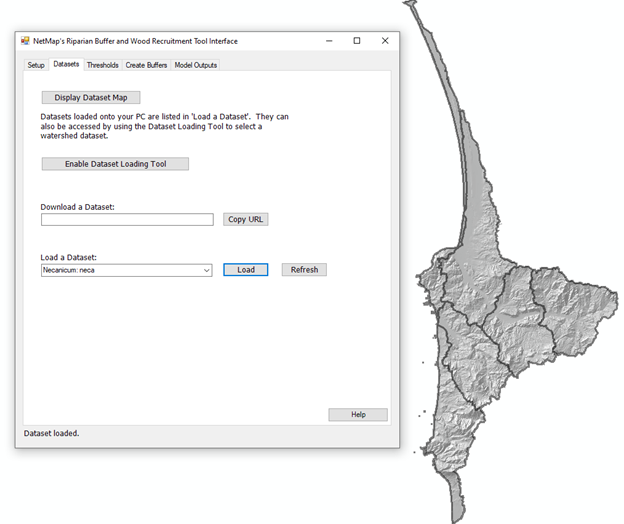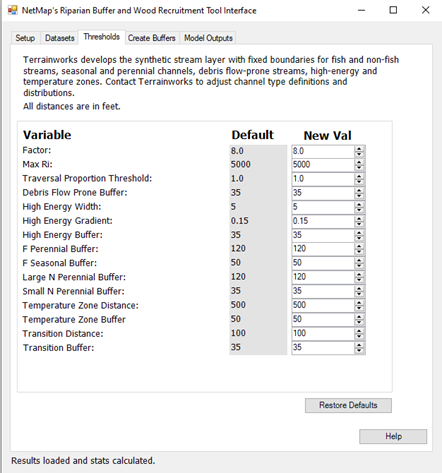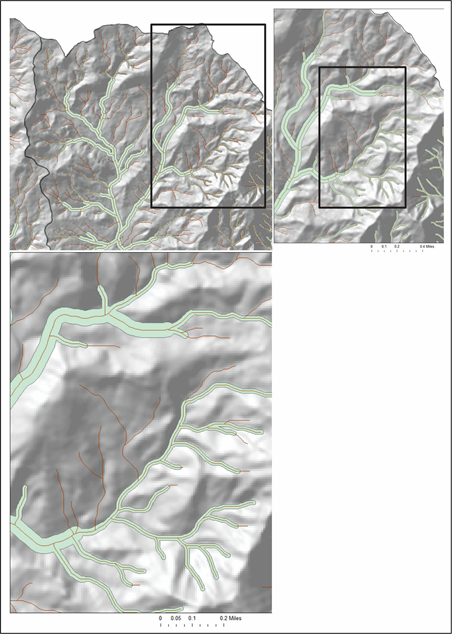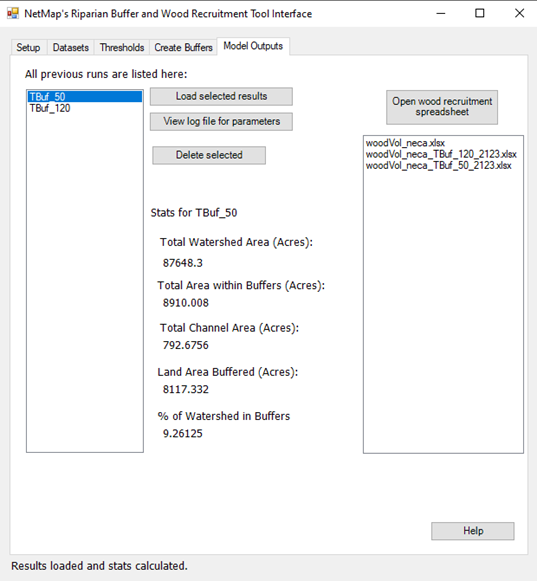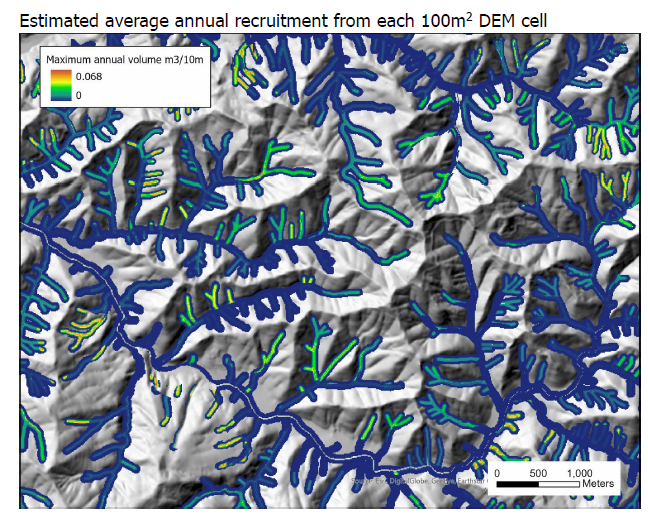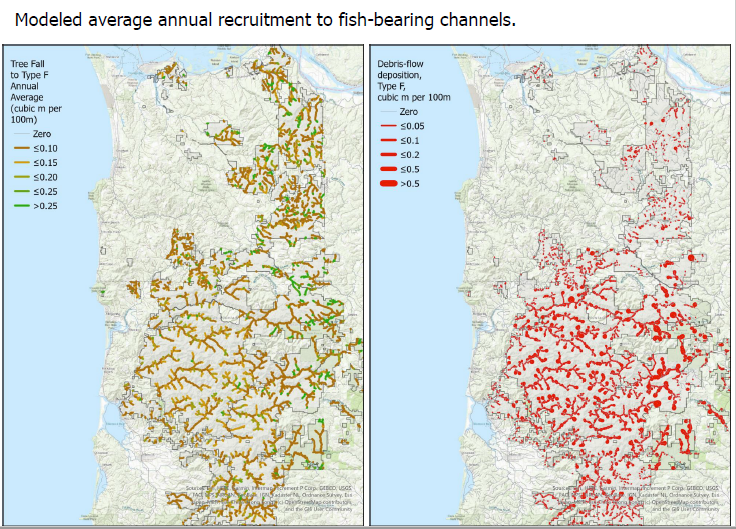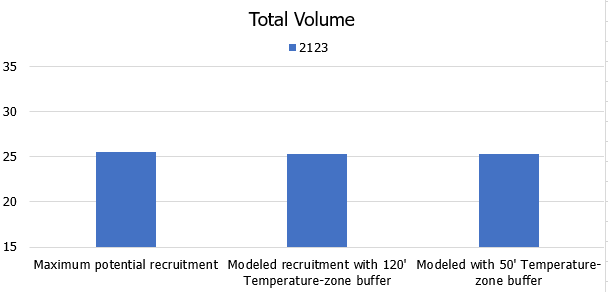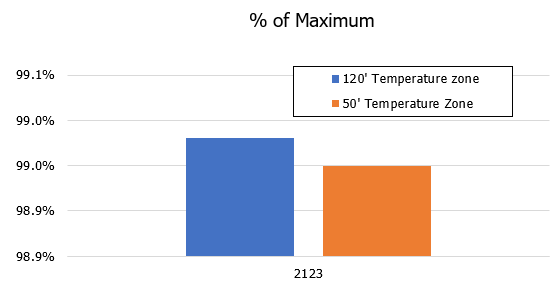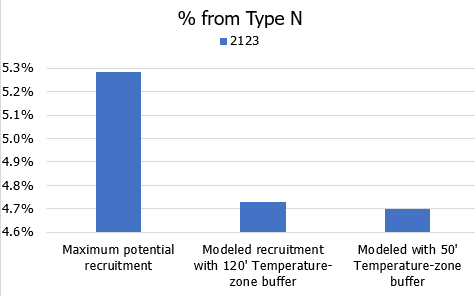Tool:
Buffer design (spatial extent and width) is based on channel classification. For the example ODF modeling presented below, channel classes included:
-
-
-
Non-fish, debris flow prone
-
Non-fish, debris flow prone with additional temperature protection zone
-
Non-fish, high energy (greater than 15%)
-
Non-fish, high energy with additional temperature protection zone
-
Non-fish small, perennial
-
Non-fish large and medium perennial
-
Non-fish perennial and seasonal transition
-
Non-fish perennial temperature zone
-
See channel class definitions below.
Riparian buffer and wood recruitment tool interface (an add-in in ArcMap 10.x).
(1) Set path to folder containing NetMap datasets for your watersheds.
(2) Display all dataset maps in your directory. Enable loading tool, then download a dataset if you haven't already. Then load the dataset to run the buffer and wood recruitment models.
(3) Set model thresholds for the different channel types.
The buffering tool delineated varying buffer widths and spatial extents based on the rules that are applied, as described above.
(4) Create the stream riparian buffers (polygons). Then select year to calculate wood recruitment (from streamside tree mortality sources and upland landslide and debris flow sources (see Technical Background below). Modeled outputs in the interface include: i) total watershed area, ii) total area within buffers, iii) total channel area, iv) total land area buffered and v) percent of watershed in buffers. These outputs are for a specific category of lands (like Oregon State forest lands) and for the larger watershed the category of lands is contained within.
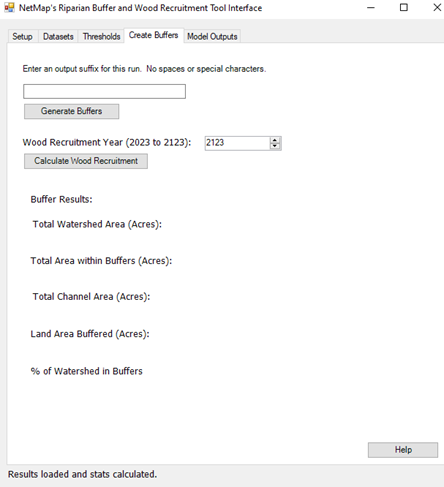
(5) Model outputs. This interface tab allows one to locate and display the various model predictions contained within GIS shapefiles and excel spreadsheets. The model runs available are listed in the left panel, along with the output excel spreadsheets on the right panel. Summary statistics are also displayed in the interface. The outputs are for a specific category of lands (like Oregon State forest lands) and for the larger watershed the category of lands is contained within.
Examples of modeled output for average annual recruitment. There are numerous other attributes in the reach shapefile, listed in Table 1 below.
Table 1. Buffer and wood recruitment attribute descriptions (meta data).
|
LSaccum
|
Expected volume of wood from standing trees carried by landslides to fish-bearing streams over a 70-year period. Reported as cubic meters per meter channel length.
|
|
LegacyAccu
|
Expected volume of legacy wood scoured by debris flows from channel segment and delivered to fish-bearing channel downstream over a 70-year period.
|
|
depAccuMax
|
Expected volume of wood deposited in reach by debris flows from tributary non-fish channels over a 70-year period. Full tree-height buffers - maximum potential volume.
|
|
depAccuBuf
|
Expected average annual volume of wood deposited in reach by debris flows from tributary non-fish-bearing channels over a 70-year period with specified buffers.
|
|
LegacyAnn
|
Expected average annual volume of wood scoured from reach by debris flow and delivered to downstream fish-bearing channel.
|
|
DF_Recur
|
Modeled recurrence interval for traversal by a debris flow or landslide that continues to a fish-bearing channel. Nodata values (-9999) indicate no modeled susceptibility to traversal by debris flows that travel to fish-bearing channels. Type N channels with recurrence intervals of 5000 years or less were considered debris-flow prone for buffer definition.
|
|
BufClass
|
Buffer Class. F_P: Type F (fish bearing) perennial (based on conflation to ODF stream layer) F_S: Type F seasonal (based on conflation to ODF stream layer) N_P_LM: Type N (non-fish) large and medium perennial (based on conflation to ODF stream layer) N_P_Temp: Type N perennial temperature zone extending 500 feet upstream from confluence with Type F N_P: Small Type N perennial N_DF_Temp: Type N debris-flow-prone temperature zone extending 500 feet upstream from confluence with Type F N_DF: Type N debris-flow prone N_HE_Temp: Type N high energy (gradient > 15%, width > 5 ft) temperature zone extending 500 feet upstream from confluence with Type F N_HE: Type N high energy N_P_S_Tran: Small Type N transition zone extending 100 feet upstream from upstream end of perennial flow N_S: Type N seasonal
|
|
DFannual
|
Expected average annual volume of wood from standing trees carried by debris flows from this reach to a fish-bearing channel downstream. Reported as cubic meters per meter channel length.
|
|
BufAccum
|
Wood volume from riparian tree fall accumulated over a 70-year period with specified riparian buffers (see BufClass and Buffer fields). Reported as cubic meters per meter channel length.
|
|
BufAnn
|
Average annual wood volume from riparian tree fall with specified riparian buffers (see BufClass and Buffer fields). Reported as cubic meters per meter channel length.
|
|
MaxAccum
|
Wood volume from riparian tree fall accumulated over a 70-year period with riparian buffers that extend at least one full tree height from the channel edge - maximum potential volume. Reported as cubic meters per meter channel length. 2028 stand conditions applied for entire period; accumulated volume accounts for wood loss to decay.
|
|
MaxAnn
|
Average annual wood volume from riparian tree fall, reported as cubic meters per meter channel length.
|
|
depAnnMax
|
Expected average annual volume of wood deposited in reach by debris flows from tributary non-fish channels with full-tree-height buffers - maximum potential volume.
|
|
LSannual
|
Expected average annual volume of wood carried by landslides to this reach. For non-fish channels, this volume reflects residence time in the channel and proportion delivered to a downstream fish-bearing stream.
|
|
LegDepAccu
|
Expected volume of legacy wood scoured from tributary non-fish channels and deposited in reach over a 70-year period.
|
|
DFaccum
|
Expected standing tree volume recruited from this reach by debris flows and delivered to fish-bearing streams over a 70-year period. Reported as cubic meters per meter channel length.
|
|
depAnnBuf
|
Expected average annual volume of wood deposited in reach by debris flows from tributary non-fish channels with specified buffers
|
Modeled outputs include the following charts in the excel spreadsheets.
